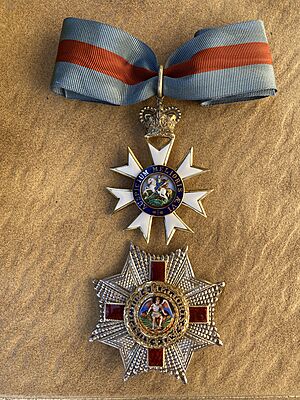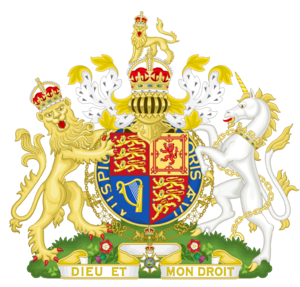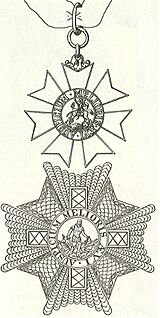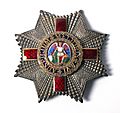Order of St Michael and St George facts for kids
Quick facts for kids Most Distinguished Order of Saint Michael and Saint George |
|
|---|---|
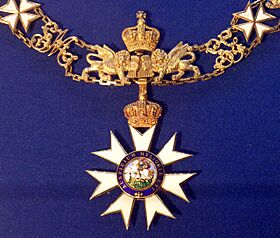
Collar and badge of the Grand Cross
|
|
| Awarded by the Monarch of the Commonwealth Realms |
|
| Type | Order of chivalry |
| Established | 28 April 1818 |
| Motto | Auspicium Melioris Ævi (Latin for 'Token of a Better Age') |
| Eligibility | Typically Commonwealth realm citizens |
| Awarded for | At the monarch's pleasure, though typically awarded for extraordinary non-military service in a foreign country or for services to foreign and Commonwealth affairs |
| Status | Currently constituted |
| Founder | Prince George, Prince Regent |
| Sovereign | Charles III |
| Grand Master | Prince Edward, Duke of Kent |
| Grades |
|
| Precedence | |
| Next (higher) | Order of the Star of India |
| Next (lower) | Order of the Indian Empire |
Ribbon bar of the Order |
|
The Most Distinguished Order of Saint Michael and Saint George is a special British award. It was started on April 28, 1818, by Prince George, who later became King George IV. At the time, he was acting as prince regent for his father, King George III. The Order is named after two important military saints: Saint Michael and Saint George.
This Order was first given to people who held important jobs in the Mediterranean areas that Britain gained during the Napoleonic Wars. Later, it was also given to people in other parts of the British Empire. Today, it is awarded to men and women who do amazing non-military work for the United Kingdom in other countries. It also honors those who provide important service in foreign and Commonwealth affairs.
Contents
Understanding the Order's Ranks
The Order has three main levels, from the highest to the lowest:
- Knight Grand Cross or Dame Grand Cross (GCMG)
- Knight Commander or Dame Commander (KCMG or DCMG)
- Companion (CMG)

This award is given to people who have done great things for the Commonwealth or other countries. For example, British Ambassadors often receive KCMG, DCMG, or CMG awards. Sir David Manning, a former British Ambassador to the US, was first a Companion (CMG). After becoming Ambassador, he was promoted to Knight Commander (KCMG). It is a common award for those working in the British Foreign and Commonwealth Office (FCO).
The Order's motto is Auspicium melioris ævi. This is Latin for "Token of a better age." Its patron saints are St. Michael the Archangel and St. George, who is the patron saint of England and soldiers. One of the main symbols of the Order shows Saint Michael defeating Satan.
This Order is the sixth most important in the British honours system. It comes after the Order of the Garter, the Order of the Thistle, the Order of St Patrick, the Order of the Bath, and the Order of the Star of India. Some of these older orders, like the one for Ireland (St Patrick) and India (Star of India), are no longer used for new awards.
History of the Order
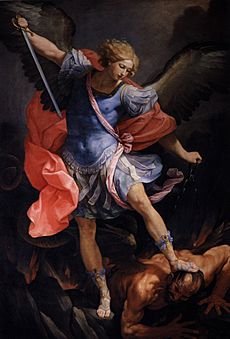
The Prince Regent created the Order to celebrate Britain's special protection over the Ionian Islands. These islands came under British control in 1814 and got their own government in 1817. The Order was meant to reward people from the Ionian Islands and Malta, as well as British subjects who held important jobs in the Mediterranean.
However, in 1864, the Ionian Islands became part of Greece. So, in 1868, the rules for the Order changed. It began to be given to those who held important jobs in Britain's colonies and for services related to the Empire's foreign affairs. Today, many Governors-General and Governors receive awards in this Order, usually as Knights or Dames Grand Cross.
In 1965, women were allowed to join the Order. Evelyn Bark was the first woman to become a Companion (CMG) in 1967.
Who Leads the Order?
The British monarch is the leader of the Order. The monarch chooses all other members, usually based on advice from the Government.
Grand Master
The second most important person in the Order is the Grand Master. This role used to be held by the Lord High Commissioner of the Ionian Islands. Now, the monarch chooses the Grand Master.
The current Grand Master, since 1967, is Prince Edward, Duke of Kent. He has served under Queen Elizabeth II and King Charles III.
The Order originally had a small number of members: 15 Knights Grand Cross, 20 Knights Commander, and 25 Companions. But it has grown a lot! Now, there can be up to 125 Knights Grand Cross, 375 Knights Commander, and 1,750 Companions. Members of the royal family and foreign "honorary members" do not count towards these limits.
Officers of the Order
The Order has six officers who help run it. For example, the Usher of the Order is called the Gentleman or Lady Usher of the Blue Rod.
Special Clothes and Symbols
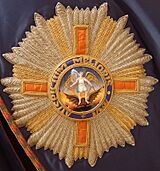
Members of the Order wear special clothing and symbols for important events like coronations. These items are different for each rank:
- The mantle is a special cloak worn only by Knights and Dames Grand Cross. It is made of blue satin with crimson silk inside. It has a star design on the left side.
- The collar is a gold chain, also only for Knights and Dames Grand Cross. It has designs of crowned English lions, Maltese Crosses, and the letters "SM" (St Michael) and "SG" (St George). In the middle, there are two winged lions holding a bible and seven arrows, which represent the seven Ionian Islands.
For less formal occasions, simpler symbols are used:
- The star is worn by Knights and Dames Grand Cross and Knights and Dames Commanders. It is pinned to the left side of the chest. The Grand Cross star is silver with gold rays. The Commander's star is smaller and silver. Both stars have a red cross of St George in the middle. They also have a blue ring with the Order's motto and a picture of St Michael defeating Satan.
- The badge is worn by all members. It hangs from a blue, crimson, and blue ribbon. Knights and Dames Grand Cross wear it on a sash. Knights Commanders and male Companions wear it around their neck. Dames Commanders and female Companions wear it on a bow on their left shoulder. The badge is a white, seven-pointed star. One side shows St Michael defeating Satan, and the other side shows St George on horseback killing a dragon. Both pictures are inside a blue ring with the Order's motto.
Before 2011, the badge showed Satan with black skin and St Michael with white skin. This was changed to show both with the same skin color. Some people felt the old image was racist. In June 2020, there were calls to completely redesign the badge. The Cabinet Office later said that members who were unhappy could exchange their old badges for the newer ones.
On certain special days, members can wear the Order's collar over their uniform or formal clothes. The badge hangs from the collar. Collars given since 1948 must be returned to the Central Chancery of the Orders of Knighthood when a member passes away. Other symbols can be kept.
The Order's Chapel
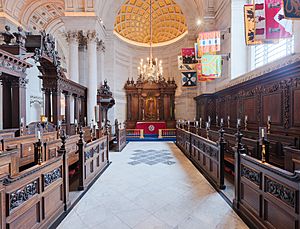
The Order's first home was a palace in Corfu. Since 1906, the Order has had its own chapel inside St Paul's Cathedral in London. Special religious services for the Order are held every four years. New Knights and Dames Grand Cross are formally welcomed at these services.
The monarch and the Knights and Dames Grand Cross have special seats in the chapel. Above their seats, their family symbols (like a helmet, crest, or coronet) and a banner with their coat of arms are displayed. A small brass plate with their name, arms, and date of joining is also attached to the back of the seat. When a Knight or Dame passes away, their banner and other symbols are taken down, but the brass plates stay there forever. This creates a colorful record of all the Knights and Dames Grand Cross since 1906.
Special Titles and Rights
Members of the Order of St Michael and St George have a special place in the order of precedence in England and Wales. This means they are ranked in a certain way for formal events.
Knights Grand Cross and Knights Commanders can use "Sir" before their first name. Dames Grand Cross and Dames Commanders can use "Dame". For example, Sir David Manning or Dame Pearlette Louisy. The wives of Knights can use "Lady" before their husband's last name. However, husbands of Dames do not get a special title from their wives. Foreign members and religious leaders do not use "Sir" or "Dame".
Members also use special letters after their names to show their rank:
- Knights and Dames Grand Cross use "GCMG".
- Knights Commanders use "KCMG".
- Dames Commanders use "DCMG".
- Companions use "CMG".
Knights and Dames Grand Cross can also add special supporters (like animals or figures) to their coat of arms. They can also show the Order's circlet (a circle with the motto) and collar around their arms. Knights and Dames Commanders and Companions can show the circlet, but not the collar, around their arms. The badge is shown hanging from the collar or circlet.
Current Leaders of the Order
The current Sovereign of the Order is King Charles III, who has been Sovereign since 2022. The current Grand Master is Prince Edward, Duke of Kent, who was appointed in 1967.
Images for kids
-
Reverse of a CMG badge showing Saint George
-
Riband, badge and star of a GCMG worn by John Buchan, 1st Baron Tweedsmuir
-
Obverse of the CMG badge showing Saint Michael
-
Riband (worn incorrectly), star and collar of GCMG worn by Francis Grenfell, 1st Baron Grenfell
-
A Seychellois stamp depicting Elizabeth II in robes of the order, 1986
-
Prince Edward, Duke of Kent, Grand Master of the Order, and Katharine, Duchess of Kent
-
The GCMG set of former Dutch Prime Minister Willem Drees
More About British Honours
- List of people who have declined a British honour
- Order of the Bath
- Order of the British Empire
- Order of the Garter
- Order of the Thistle
- Royal Victorian Order
See also
 In Spanish: Orden de San Miguel y San Jorge para niños
In Spanish: Orden de San Miguel y San Jorge para niños


